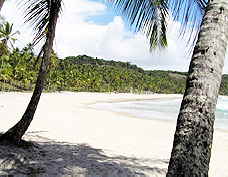Bahia, a state located in the northeast part of Brazil, is a tropical paradise of rainforests, cacoa, coconut and sugarcane plantations, exotic cuisine, pristine stretches of beaches, historic churches, and was the home of the esteemed Brazilian writer, Jorge Amado, who was born in 1912.

Regina, Gilberto, Debra and Ed
The city of Ilheus, where Jorge Amado lived, figured prominently in many of his books, including Gabriela, Clove and Cinnamon, Shepherds of the Night and Dona Flor and her Two Husbands, where he captured the essence of Ilheus and Bahia and brought it to his readers. It is far away from the state of São Paulo, not only designated by the physical miles but by the culture as well. Bahia is an exotic beauty that whispers, and sometimes shouts, Carnival, all year long.
Edward F. Nesta and I had been to Salvador many years ago, but we had not explored the other cities of Bahia. In January 2005, we decided to remedy the situation, and traveled with our friends, Regina and Gilberto Sacilotti, first to Itacaré, and then Ilheus, and finally made a stop in Salvador. We flew to Ilheus, and decided to spend two nights at an eco resort to find out what an eco resort is all about. Itacaré Eco Village, http://www.ecovillage.com.br/, (read about the hotel in more detail in Hotels & Resorts), located 50 minutes from the airport in Ilheus, shows that eco friendly can be done very well, especially when they have waterfalls, immaculate private beaches, and gorgeous views. Itacaré Eco Village is located just 20 minutes from the center of Itacaré, but is worlds apart from this sleepy little artsy town. Itacaré is definitely stuck in the 1970’s from the music, (think Bob Marley reggae and 70’s rock), to the hippie clothing and crafts. However, it is a friendly place where we found a sidewalk bar that made great cocktails with passion fruit juice and Malibu Coconut Rum, and a tropical fruit called açerola, which was also mixed with Malibu Coconut Rum. One little treasure though was a smart and sophisticated restaurant called, Restaurante Dedo de Moça, where we had a really nice dinner.
After Itacaré, we spent three nights at Hotel Transamérica Ilha de Comandatuba, http://www.transamerica.com.br/, which is located in Una, about 50 minutes from Ilheus, and is on a private island. For years I had wanted to go there, but never actually made it, and decided that this year I would finally get there. The wait was definitely worth it!  This fantasy private island has 21 km of continuous white sandy beaches, and enough activities to suit most everyone. One of our typical days included having a sumptuous buffet breakfast, followed by riding ATVs (All Terrain Vehicles, also called “quadricycles”, which are 4-wheel motorcycles), along the beach and over the trails, taking a crab walk along the raised boardwalk where we watched fascinated as the land crabs scrambled in and out of the black mud and the roots of the mangrove trees, followed by windsurfing for Gilberto and sailing Hobie Cats for Edward and I, as Regina relaxed in the shade of a coconut tree.
This fantasy private island has 21 km of continuous white sandy beaches, and enough activities to suit most everyone. One of our typical days included having a sumptuous buffet breakfast, followed by riding ATVs (All Terrain Vehicles, also called “quadricycles”, which are 4-wheel motorcycles), along the beach and over the trails, taking a crab walk along the raised boardwalk where we watched fascinated as the land crabs scrambled in and out of the black mud and the roots of the mangrove trees, followed by windsurfing for Gilberto and sailing Hobie Cats for Edward and I, as Regina relaxed in the shade of a coconut tree. 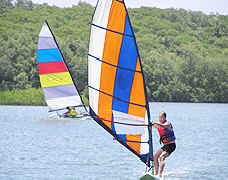 Afterwards we all kayaked along a small island that was teeming with tropical birds, and were mesmerized as flying fish jumped in the air around our kayaks. Too bad we did not have fishing nets with us, as we could have easily caught a few! Next on the day’s agenda was taking the hotel’s mini-train to the pool area where Regina had us using the “step machines” in one of the pools, and then rode the giant waterslide into the pool. After a quick shower, Edward and I were off to play a round of golf with Rubenval Costa, from the Golf Course. This spectacular 18-hole golf course has long fairways and many water obstacles, not including the holes that are alongside the beach where the ocean views tempt you to take your eyes off the ball and gaze out to sea. After a short nap in a white-fringed hammock under a coconut tree, listening to the afternoon live classical music, we were ready for a stroll along the beach. The beach in the late afternoon sun was breathtaking, as the light had shifted and created the most marvelous shadows and reflections as we walked along the endless stretch of beach. Returning to our room, we found a note from Regina and Gilberto who suggested that we take the hotel’s ferry service into the little town to do some shopping. A quick shower and we were riding the ferry boat 5 minutes to the mainland, where in the course of less than an hour, (as the stores were closing), we returned to the ferry boat laden with our many purchases. Stashing the packages in our rooms, we changed our clothes and went to the Bahian Night Buffet, which really captured the flavors of Bahia with such exotic main dishes as: Caruru, (okra purée with shrimp and dendê oil), Pirão de Peixe, (creamy paste of cooked fish and manioc flour), Vatapá, (seafood stew with peanuts and cashew nuts), Bobó de Camarão, (shrimp stew with mashed manioc, coconut milk and palm oil), Ximxim de Galinha, (chicken with shrimp, peanuts and cashew nuts), Jabá com Jerimem, (jerked beef with pumpkin), Moqueca de Peixe a Baina, (fish stew with coconut milk and palm oil), and Arroz de Víuva (Widow’s rice which is rice cooked with coconut milk). Dessert lovers had an incredible tempting selection of Cocadas, (coconut candies), Torta de Brigadeiro, (a chocolate fudge-like cake), Pudim de Leite, (milk pudding), Rocambole de Amendoim, (peanut Swiss roll), Torta de Tapioca, (tapioca cake), Cocado de Forno (baked coconut), Manjar de Coco, (kind of like a steamed pudding), and many more. (Please read Chefs' Recipes for the recipes.) After dinner, we strolled along the grounds under starry skies, and then danced the night away at the beach to the high energy, national Brazilian band, Márcia Alencar and her band, who performed on a large outdoor stage, and played Carnival, typical Bahian music and Axé, which is a type of music popular in the northeast.
Afterwards we all kayaked along a small island that was teeming with tropical birds, and were mesmerized as flying fish jumped in the air around our kayaks. Too bad we did not have fishing nets with us, as we could have easily caught a few! Next on the day’s agenda was taking the hotel’s mini-train to the pool area where Regina had us using the “step machines” in one of the pools, and then rode the giant waterslide into the pool. After a quick shower, Edward and I were off to play a round of golf with Rubenval Costa, from the Golf Course. This spectacular 18-hole golf course has long fairways and many water obstacles, not including the holes that are alongside the beach where the ocean views tempt you to take your eyes off the ball and gaze out to sea. After a short nap in a white-fringed hammock under a coconut tree, listening to the afternoon live classical music, we were ready for a stroll along the beach. The beach in the late afternoon sun was breathtaking, as the light had shifted and created the most marvelous shadows and reflections as we walked along the endless stretch of beach. Returning to our room, we found a note from Regina and Gilberto who suggested that we take the hotel’s ferry service into the little town to do some shopping. A quick shower and we were riding the ferry boat 5 minutes to the mainland, where in the course of less than an hour, (as the stores were closing), we returned to the ferry boat laden with our many purchases. Stashing the packages in our rooms, we changed our clothes and went to the Bahian Night Buffet, which really captured the flavors of Bahia with such exotic main dishes as: Caruru, (okra purée with shrimp and dendê oil), Pirão de Peixe, (creamy paste of cooked fish and manioc flour), Vatapá, (seafood stew with peanuts and cashew nuts), Bobó de Camarão, (shrimp stew with mashed manioc, coconut milk and palm oil), Ximxim de Galinha, (chicken with shrimp, peanuts and cashew nuts), Jabá com Jerimem, (jerked beef with pumpkin), Moqueca de Peixe a Baina, (fish stew with coconut milk and palm oil), and Arroz de Víuva (Widow’s rice which is rice cooked with coconut milk). Dessert lovers had an incredible tempting selection of Cocadas, (coconut candies), Torta de Brigadeiro, (a chocolate fudge-like cake), Pudim de Leite, (milk pudding), Rocambole de Amendoim, (peanut Swiss roll), Torta de Tapioca, (tapioca cake), Cocado de Forno (baked coconut), Manjar de Coco, (kind of like a steamed pudding), and many more. (Please read Chefs' Recipes for the recipes.) After dinner, we strolled along the grounds under starry skies, and then danced the night away at the beach to the high energy, national Brazilian band, Márcia Alencar and her band, who performed on a large outdoor stage, and played Carnival, typical Bahian music and Axé, which is a type of music popular in the northeast.
The next day we indulged ourselves in Spa treatments at the Spa L’Occitane, (read about our experiences at Spa L’Occitane in the Spa section), followed by a boat ride 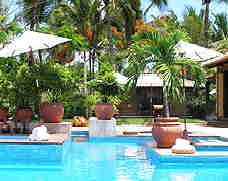 to a black mud beach, where the captain reached down into the warm waters and brought up rich black mud, which was warm and smooth as we applied the mud to our skin. Gilberto got a little carried away though, and covered not only his body in the mud, but his hair as well. We laughed and posed while waiting for the mud to dry, and then swam in the warm water to remove the dried mud. When we emerged, the captain poured clean fresh water over our heads to remove the last remains of the mud treatment, and our skin felt incredibly smooth and soft. No wonder the Spas charge so much for this treatment. In the evenings, there were always several venues of live music to choose from, as well as different game tournaments each night, including canasta and backgammon tournaments. Everyday at breakfast, guests would find a program for the day, with interesting activities throughout the day and into the evening. One day’s program included bocce, surf lessons, stretching, beach games, capoeira class, water gymnastics, a donkey race, darts tournament, Axé class (dance), archery, circus class, beach volleyball, Forró class (dance), soccer, gym class, stretching, spinning class, cards tournament, and of course, there was always time to listen to music beginning at breakfast, as well as relax with a snack or a cocktail at one of the pool bars.
to a black mud beach, where the captain reached down into the warm waters and brought up rich black mud, which was warm and smooth as we applied the mud to our skin. Gilberto got a little carried away though, and covered not only his body in the mud, but his hair as well. We laughed and posed while waiting for the mud to dry, and then swam in the warm water to remove the dried mud. When we emerged, the captain poured clean fresh water over our heads to remove the last remains of the mud treatment, and our skin felt incredibly smooth and soft. No wonder the Spas charge so much for this treatment. In the evenings, there were always several venues of live music to choose from, as well as different game tournaments each night, including canasta and backgammon tournaments. Everyday at breakfast, guests would find a program for the day, with interesting activities throughout the day and into the evening. One day’s program included bocce, surf lessons, stretching, beach games, capoeira class, water gymnastics, a donkey race, darts tournament, Axé class (dance), archery, circus class, beach volleyball, Forró class (dance), soccer, gym class, stretching, spinning class, cards tournament, and of course, there was always time to listen to music beginning at breakfast, as well as relax with a snack or a cocktail at one of the pool bars.
Since the direct flight from Ilheus to São Paulo was sold out, we flew from Ilheus to Salvador where we had a 4-hour layover, before our flight to São Paulo, which was perfect. We hired a taxi from the airport, and the driver drove us to the city of Salvador. 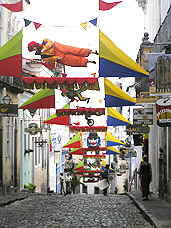 We explored this historic city that has many colonial buildings, mansions, museums, palaces, and churches each more resplendent then the next with their interiors covered with gold leaf. Many of the buildings date back to the 16th century. It is a charming city to explore the many shops, as well as to purchase gemstones, since Bahia is well recognized for their gemstones such as emeralds, aquamarines, topaz, amethyst, citrine and tourmaline. When we were there in late January, the city was preparing for the Carnival season, and Salvador was being accessorized in Carnival attire. There was music in the streets, and the air seemed electric with excitement.
We explored this historic city that has many colonial buildings, mansions, museums, palaces, and churches each more resplendent then the next with their interiors covered with gold leaf. Many of the buildings date back to the 16th century. It is a charming city to explore the many shops, as well as to purchase gemstones, since Bahia is well recognized for their gemstones such as emeralds, aquamarines, topaz, amethyst, citrine and tourmaline. When we were there in late January, the city was preparing for the Carnival season, and Salvador was being accessorized in Carnival attire. There was music in the streets, and the air seemed electric with excitement. 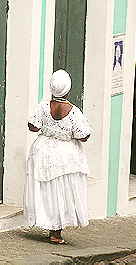 Women in traditional Bahian attire could be found everywhere either selling sweets or handing out brochures, adding to the exotic appeal of Bahia. There is a large market where the vendors sell everything from beautifully embroidered and crocheted linens, spices, t-shirts, jewelry and the usual souvenirs one finds at this type of market. Be prepared for crowds though, as the market is always busy. For me, I prefer shopping in the smaller shops and boutiques, even if the prices are slightly higher. We walked to our pre-arranged spot to meet our driver, who drove us back to the airport. We ordered large ice creams of many tropical flavors to leave a sweet impression of our time in Bahia, before boarding the plane to return to São Paulo. Ah, Bahia, until we return again.
Women in traditional Bahian attire could be found everywhere either selling sweets or handing out brochures, adding to the exotic appeal of Bahia. There is a large market where the vendors sell everything from beautifully embroidered and crocheted linens, spices, t-shirts, jewelry and the usual souvenirs one finds at this type of market. Be prepared for crowds though, as the market is always busy. For me, I prefer shopping in the smaller shops and boutiques, even if the prices are slightly higher. We walked to our pre-arranged spot to meet our driver, who drove us back to the airport. We ordered large ice creams of many tropical flavors to leave a sweet impression of our time in Bahia, before boarding the plane to return to São Paulo. Ah, Bahia, until we return again.
For additional information on Bahia, please contact the Bahia Tourism Office at: www.bahia.com.br.
Please read our other articles on Brazil and Bahia in Destinations, Hotels & Resorts, Restaurants, Gastronomy, Chefs' Recipes, Spas and Music Scene.
© April 2005. Luxury Experience. www.LuxuryExperience.com. All rights reserved.

